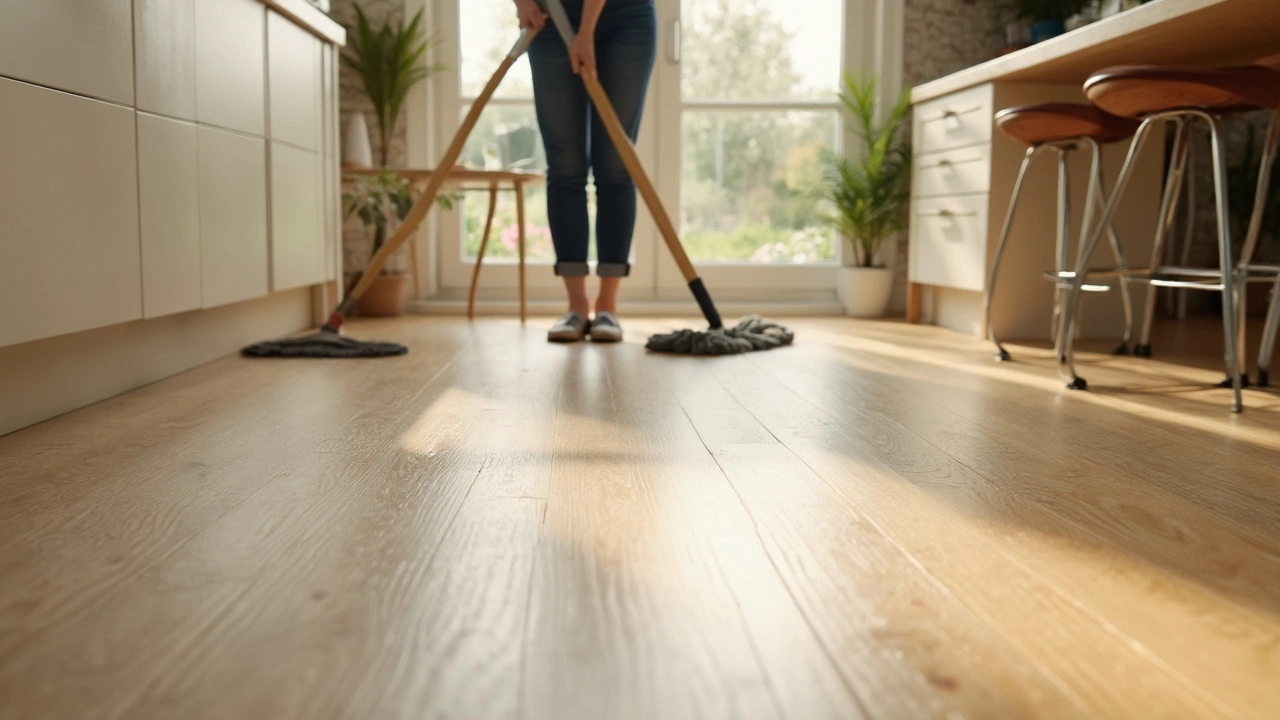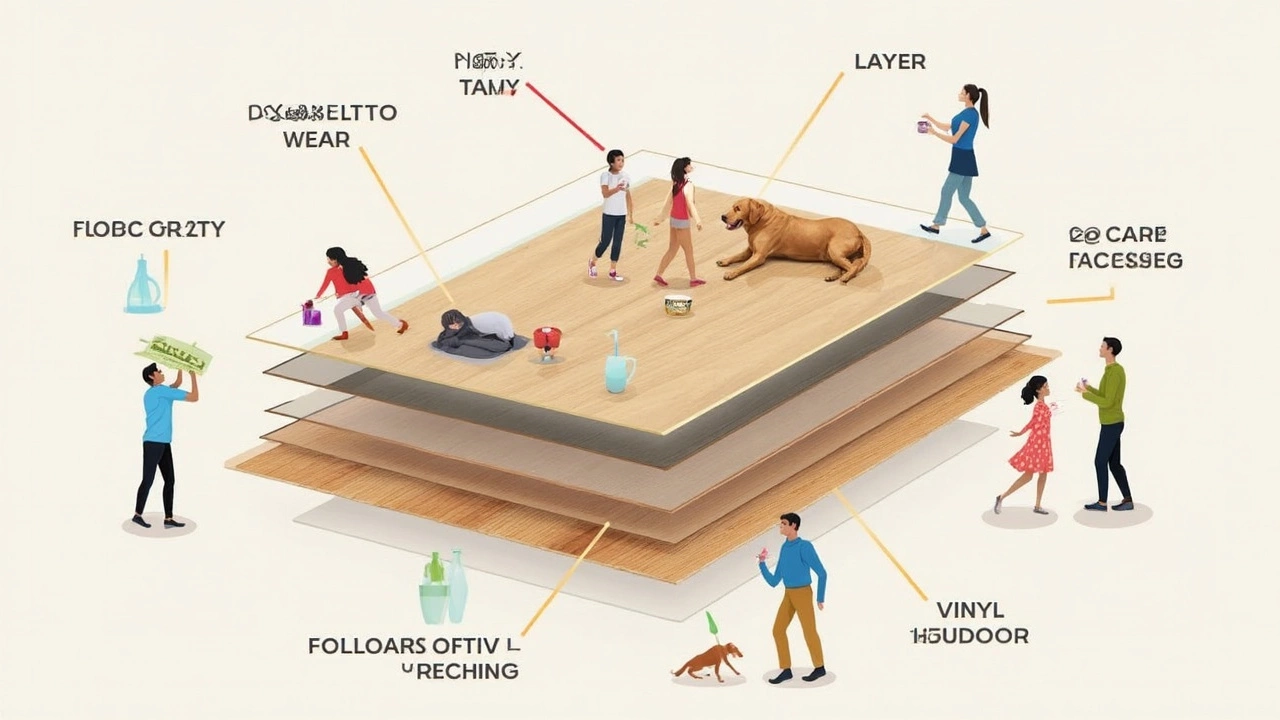How Long Does Vinyl Flooring Last? Real Lifespans & Pro Tips

When people talk about vinyl flooring, they usually want to know one thing: how many years does it actually last? Spoiler—it's not the same for everyone. You might see slick marketing claiming “up to 25 years,” but real life depends on how you treat it, where you use it, and what quality you chose at the start.
Here’s the straight talk: decent vinyl flooring can stick around for 10 to 20 years, sometimes a little more if you’re lucky or super gentle on your floors. Got kids, pets, heavy furniture dragging across the surface, or maybe you don’t sweep as often as you probably should? All that shortens its lifespan.
Think about where you’re putting it. Kitchens, hallways, and bathrooms see way more action than a spare bedroom, so vinyl won’t last as long in the busy zones. And the better quality you buy, the longer it’ll hold up. There’s a huge difference between cheap, peel-and-stick planks and the thick, sturdy stuff with a good wear layer.
- Understanding Vinyl Flooring Lifespans
- Big Factors That Make or Break Longevity
- Simple Ways to Extend Your Flooring’s Life
- When to Replace: Signs Your Vinyl Is Done
Understanding Vinyl Flooring Lifespans
Vinyl flooring is famous for being tough, but there’s more to the story than just slapping it down and forgetting about it. The real lifespan depends on a mix of everyday use, where it’s installed, and what type you’ve picked in the first place. Manufacturers throw out bold promises, but let’s get real and see what you can actually expect.
Most good-quality vinyl floors last anywhere from 10 to 20 years in a regular home. If you opt for top-shelf, commercial vinyl, you might squeeze a couple more years out of it. For rentals or rooms that don’t see much action, some folks have stretched that number close to 25 years. But that’s usually with basic care—no wild parties or constant dragging of sharp objects.
Here's a quick breakdown of what typically affects lifespan:
- Type of vinyl: Luxury vinyl planks (LVP) and luxury vinyl tiles (LVT) with thicker wear layers outlast basic peel-and-stick tiles every time.
- Where you put it matters: Busy entryways and kitchens wear out faster than bedrooms or guest rooms.
- Care and cleaning routines: Regular sweeping and the right cleaning products go a long way.
- Exposure to sunlight: Direct UV rays can fade and weaken vinyl over the years.
When you shop, look for the thickness of the wear layer—the clear, tough coat on top. That’s your main shield against dents and scratches. Most home vinyl flooring comes with a wear layer somewhere between 8 and 12 mil (that’s thousandths of an inch, and yes, it matters).
| Type of Vinyl | Typical Lifespan (Years) | Wear Layer (Mil) |
|---|---|---|
| Peel-and-stick Tile | 5-10 | 4-8 |
| Standard Vinyl Sheet | 10-15 | 8-10 |
| Luxury Vinyl Plank/Tile | 15-20+ | 12-20 |
| Commercial Vinyl | 20-25 | 20+ |
So, before you get sold on looks alone, double-check the specs and know how long that style will actually last. In short: vinyl flooring has staying power, but only if you pick wisely and know what affects its clock.
Big Factors That Make or Break Longevity
Not all vinyl floors are created equal, and several key things decide how long yours will actually last. The vinyl flooring you pick and what you do next matter way more than you’d think.
First up, let’s talk about quality. Higher-end vinyl comes with a thicker wear layer. That’s the clear, tough stuff on top that takes all the hits from shoes, chairs, pets, and spilled stuff. A 20-mil wear layer is what you want if your house is busy. Thin layers may look fine on day one, but they’ll scuff up and wear out fast.
Next, how you install vinyl flooring makes a major difference. If you put planks or tiles down on an uneven surface, they’ll start shifting, cracking, or popping up over time. A smooth, clean subfloor is non-negotiable if you care about durability.
Location is another huge one. Putting vinyl in areas with lots of sunlight? Watch for fading. If it’s in a kitchen or bathroom, water spills can seep into seams if not cleaned up fast, which leads to lifting or curling. Entryways take a beating from dirt and grit—think about using entry mats to stop wear before it happens.
Daily life and cleaning habits also have a big say. Pushing heavy furniture without pads? That’s asking for gouges. Using harsh cleaners like bleach? That’ll break down the wear layer way faster. Sweep and mop with something gentle. Stick to what’s recommended by the brand, or you might void the warranty without even knowing it.
Finally, be aware—pets and kids kick the wear-and-tear level up big time. Houses with lots of foot traffic or little ones playing on the floor just won’t see the same lifespan as drama-free guest rooms.
- Quality of the wear layer
- Proper installation (flat, clean subfloor)
- Where you put it (sun, water, dirt exposure)
- Furniture and movement
- How you clean it (and what you use)
- Amount of daily traffic and use
So if you want to get the most years out of your vinyl planks or tiles, focus on these key things from the start, and don’t overlook the everyday habits that can wreck your floors a lot faster than you expect.

Simple Ways to Extend Your Flooring’s Life
If you want your vinyl flooring looking sharp for as long as possible, the real secret is in the simple stuff you do every day. Even small habits add up. Let’s cover what actually works—not just the usual advice.
First up: sweeping or vacuuming. Dirt acts like sandpaper, scratching up your vinyl with every step. The National Wood Flooring Association says,
"Regular dust removal is the most effective way to fight surface scratches and keep flooring finishes looking brand new for years."So, grab that broom or get your vacuum out twice a week, minimum—daily if you’ve got a busy family or pets.
Watch the water. Vinyl resists water, but it’s not totally waterproof. Never let puddles or spills sit—mop them up right away. When you clean, use just a damp mop with a gentle cleaner made for vinyl. Skip bleach and harsh chemicals, since those can eat away at the protective layer. If you love numbers, a 2024 survey by Home Insight found that 63% of vinyl floor damage came from using the wrong cleaners.
Furniture is another big culprit. Anything heavy needs felt pads on the legs—no exceptions. For rolling chairs, get a plastic mat to avoid tracks and dents. Want to really play it safe? Lift furniture instead of dragging it, and keep an eye out for grit stuck in the pads, which can still scratch your floors.
Here’s a quick list of actionable tips that make a real difference:
- Sweep or vacuum at least twice a week.
- Keep floors dry—wipe spills immediately.
- Stick to vinyl-safe cleaning products.
- Use doormats at entrances to catch grit before it hits your floors.
- Add felt pads under all furniture legs.
- Protect against sun damage—close blinds during peak hours to stop fading.
Here’s a handy table showing what helps—and what hurts—vinyl flooring over time:
| Habit | Good or Bad? | Impact on Lifespan |
|---|---|---|
| Daily sweeping | Good | Increases by 2-5 years |
| Using harsh cleaners | Bad | Decreases by 3 years |
| Adding felt pads to furniture | Good | Increases by 1-2 years |
| Letting water pool | Bad | Can cut lifespan in half |
| Installing entry mats | Good | Protects high-traffic spots |
Stay on top of these simple tricks and your vinyl could easily outlast the average.
When to Replace: Signs Your Vinyl Is Done
No one likes to rip up their vinyl flooring earlier than they need to. But after a certain point, repairs and deep cleaning just won’t cut it. So what actually tells you it's time to swap yours out?
Here are the red flags:
- Deep Scratches or Gouges: A few scratches are normal, but if you notice deep cuts or big damaged patches, that's a sign the protective top layer is gone. Dragging furniture or repeated pet claws will speed this up.
- Curling Edges or Seams: When corners start curling or seams pop up, not only does it look rough—it can trip you or collect grime you can't clean out. This usually means the adhesive has lost its grip or moisture’s snuck underneath.
- Stains That Won’t Budge: If regular mopping and even strong cleaners don’t lift stains, those marks are in for good. This happens most with white or light-colored vinyl.
- Fading and Discoloration: Sun can bleach certain spots, making the floor look patchy. Bleach and harsh chemicals also kill the color for good.
- Peeling or Cracking: Age shows up as peeling corners or surface cracks. That’s a sign the vinyl is brittle and won't handle heavy use anymore.
Heavy traffic and cleaning mistakes can speed this up. Here’s a quick table showing how long most folks end up getting out of their vinyl in different rooms (assuming average wear):
| Room | Average Lifespan (years) |
|---|---|
| Kitchen | 8–12 |
| Bathroom | 7–10 |
| Living Room | 12–18 |
| Bedroom | 15–20 |
Spotting these signs early can save you headaches. If you ignore them, things get worse—mold, tripping, or even a full-on water leak under the floor. If you’re noticing more than one issue, it’s probably time for that upgrade.


